Succulent beef slices complemented with the heat of chilli peppers, the authentic version of Hunan beef bursts with wonderful flavours and it’s very quick to cook.
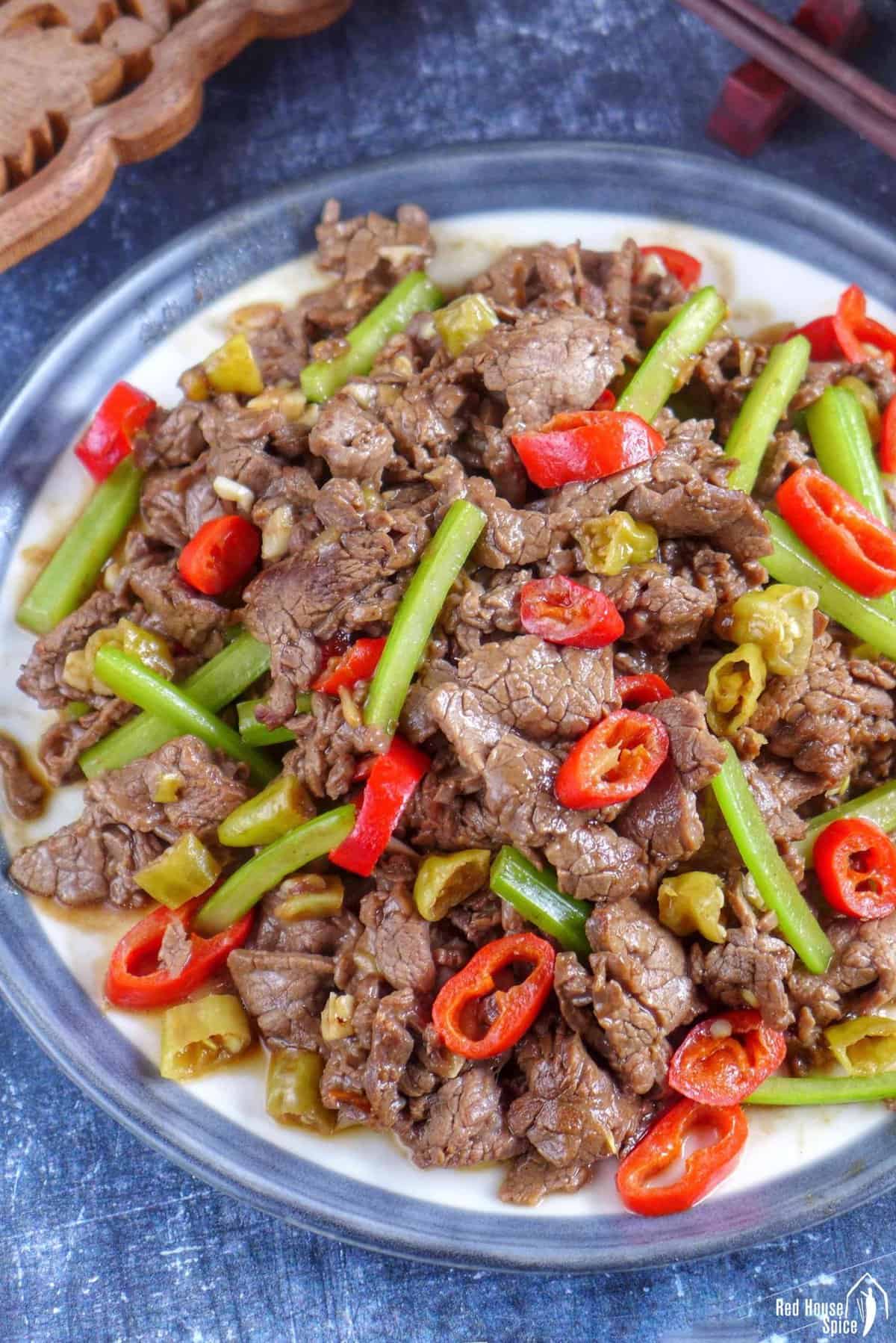
Hunan beef the authentic way
In overseas Chinese restaurants, you often see dishes labelled with two elements: the name of a Chinese province/city and the star ingredient. Hunan Beef is one example, along with Szechuan chicken, Peking ribs, etc. But with lots of adaptation, they don’t always reflect the classic flavour profile of the cuisine of that region.
Today’s dish, Hunan beef stir-fry(小炒黄牛肉) may not taste similar to what you’d get from a takeaway/takeout, but it will definitely help you to understand why many believe Hunan cuisine (Xiang Cai, 湘菜) tastes just as good as Sichuan food and deserves equal recognition.
Similar to Hunan Pork that I shared previously, this beef dish stands out for its piquant, smoky and bold flavour. Also, the super fast cooking process ensures that the meat tastes as succulent as possible.
Ingredients
For this simple stir-fry, you’ll need some fairly common ingredients. I’ll list them in four groups and tell you how they contribute to the dish.
Beef
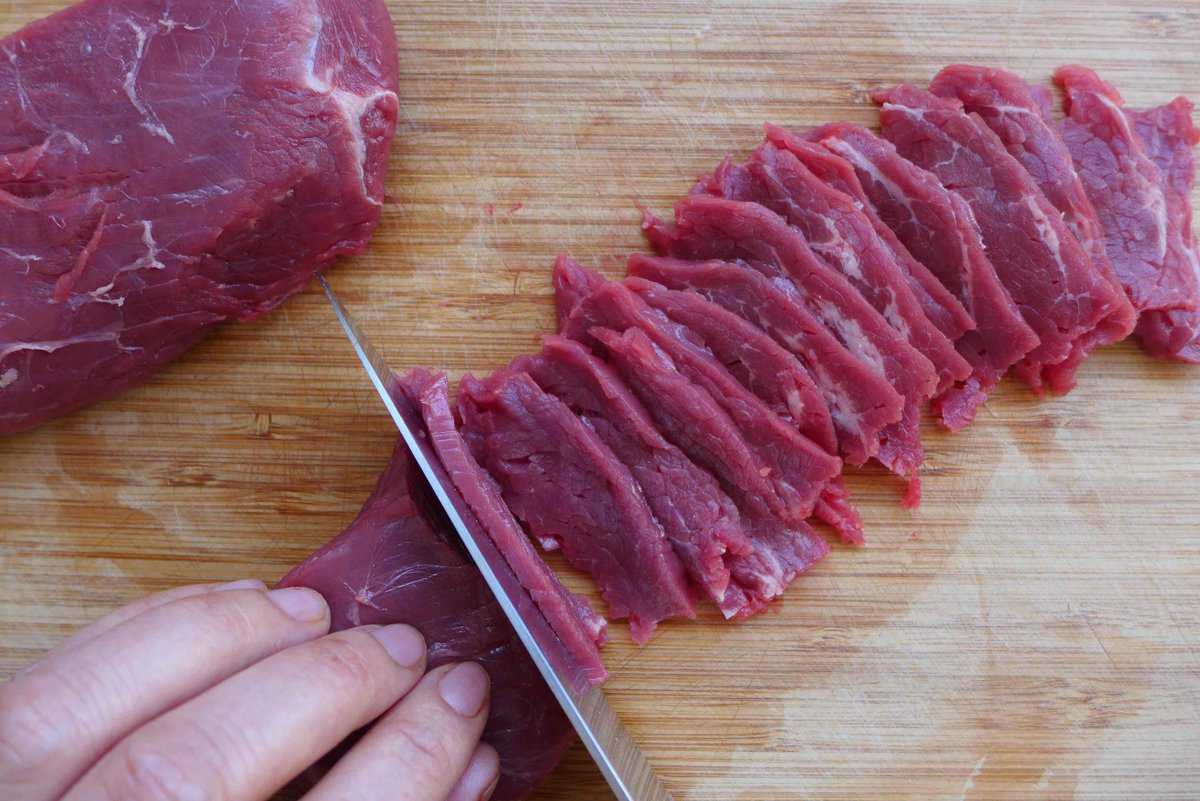
For best results, you’ll need a beef cut that’s flavourful and tender enough for a quick stir-fry. Like for Black Pepper Beef, my favourite is skirt steak which is moderately priced and suitable for most cooking methods. When sliced thin and cooked over high heat for a short period, it tastes luscious and succulent.
Other suitable beef cuts include flank, sirloin, tri-tip, round steak, etc. If you’d like to learn more, check out the Simple Guide of Cuts of Beef on FoodBeast.
Chillies
The second important ingredient is chilli peppers. They provide a kick of heat that’s essential to authentic Hunan beef. Two different types are used in my recipe.

- Fresh chilli peppers. You may choose whatever type that suits your tolerance to heat. I used a medium-heat variety simply labelled as red chillies in UK supermarkets.
- Pickled chilli peppers. Known as Pao Jiao/泡椒 in Chinese, they taste hot and acidic so are very good at reviving any bland dish. They usually come in jars or plastic packaging and can be found in Chinese stores.
🛎 Substitutes: If you have trouble sourcing Chinese pickled chilli, try similar versions from other cuisines. I’ve tried Spanish ones which I think are a reasonable substitute. Another alternative is Hunan style pickled chilli garlic sauce that can be easily made at home.
Aromatics
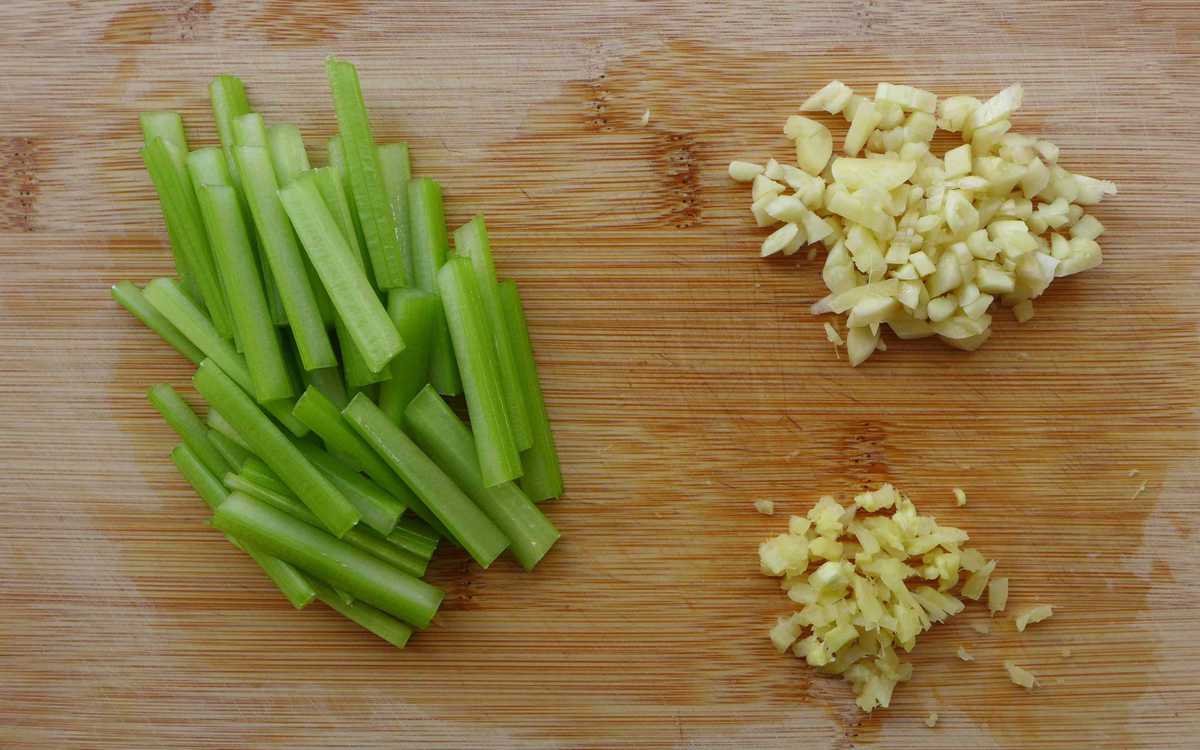
For extra fragrance and an addition of crunchy texture, I like adding some celery to the dish. It can be replaced by a generous bunch of coriander (cilantro) if you prefer. Also, coarsely mince some garlic and ginger as they’re nearly indispensable for Chinese stir-fries.
Seasonings
The seasonings for this dish are a set of basic Chinese condiments added to marinate the beef before cooking: Oyster sauce, light and dark soy sauce, Shaoxing rice wine, white pepper and cornstarch. There is enough saltness in these sauces and pickled chillies, so you wouldn’t need extra salt.
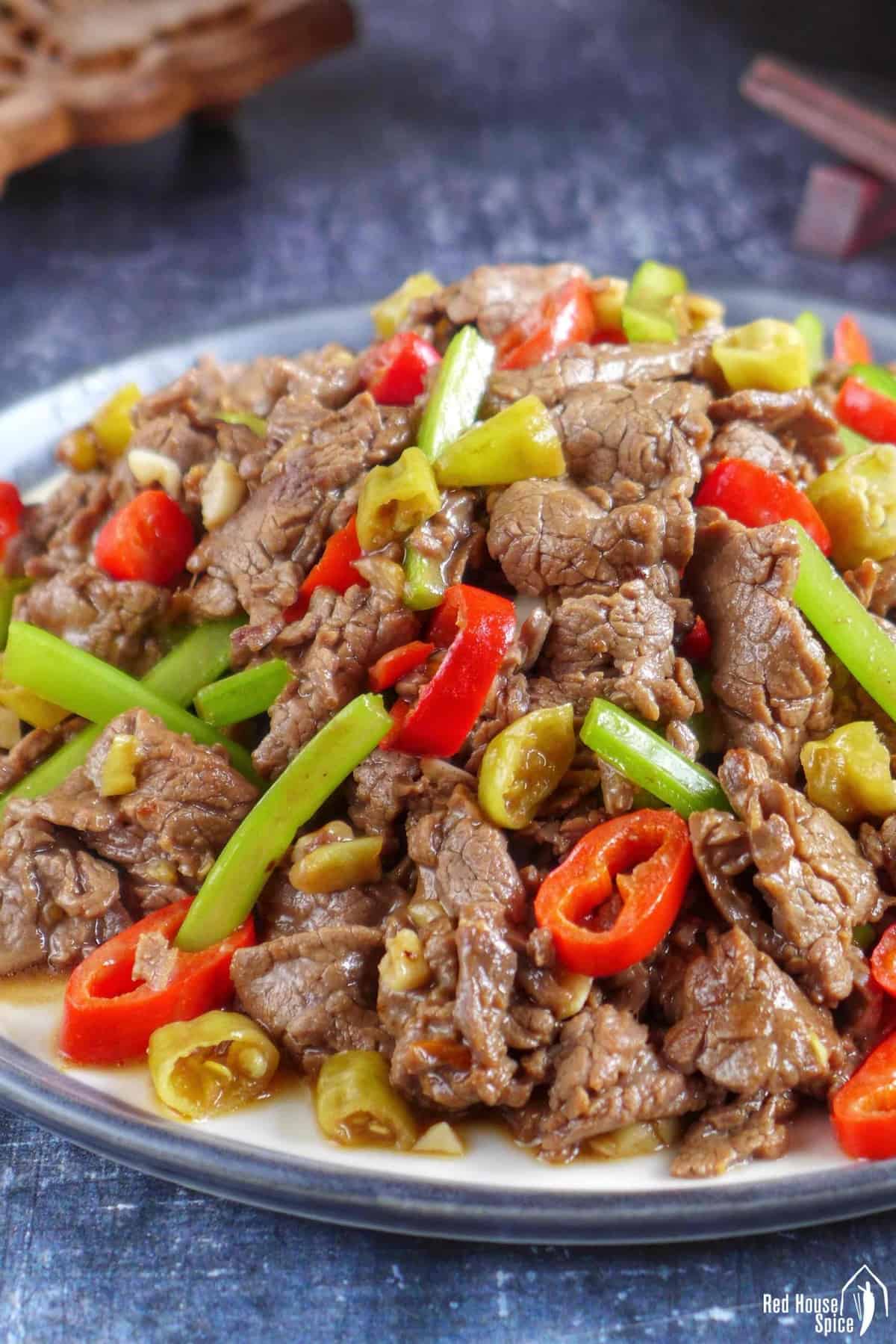
Cooking procedure
It couldn’t be simpler to cook Hunan beef. Yet still, you’d need to pay attention to a few things to make it top-notch. While explaining the cooking steps, I’ll also highlight some tips to help you succeed.
Step 1: Slice the beef
With a sharp knife, cut the beef into thin slices (no thicker than a coin). It’s important that you cut it across, not along, the grain of the meat. This will prevent chewiness.
If you aren’t confident in slicing fresh meat, leave it in the freeze for 1-2 hours until semi-frozen. It’s much easier and quicker to cut a firm piece of meat.
Step 2: Marinate the beef
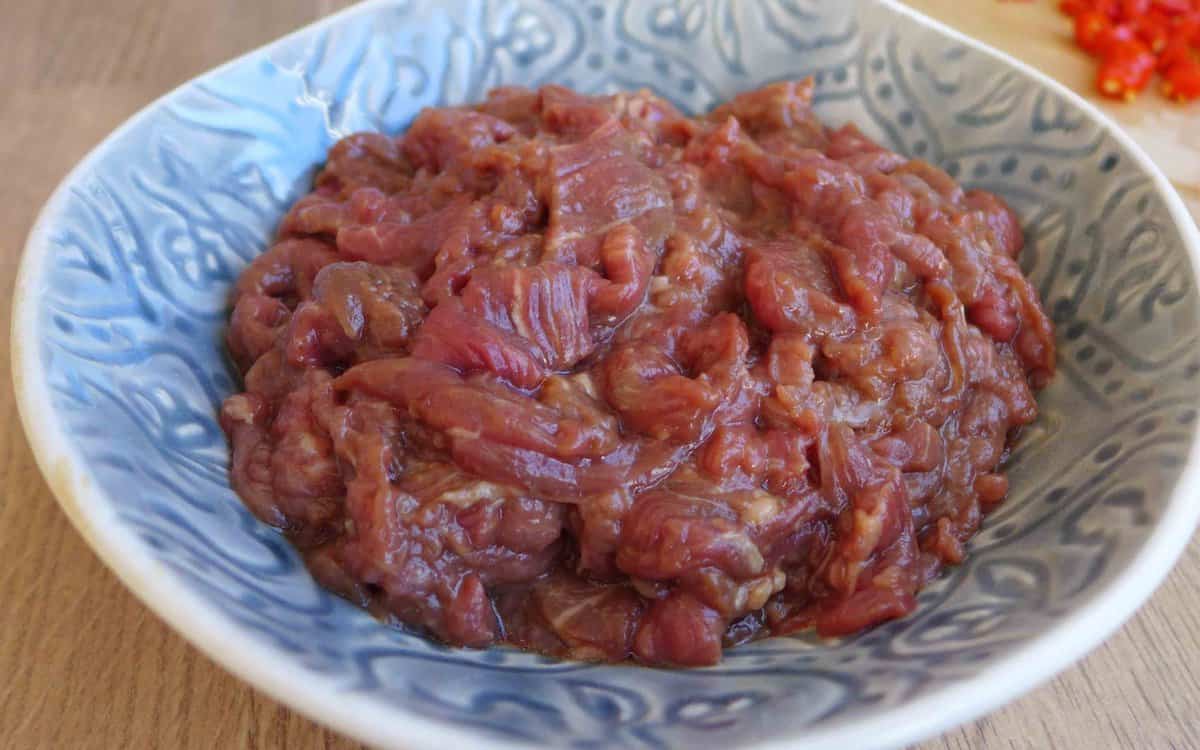
Different from saucy Chinese stir-fries, such as Pepper Steak and Garlic Sauce Pork, there isn’t any sauce for this dish. All the seasonings are for marinating the beef. So you don’t need to add any condiments while cooking.
In a bowl, mix oyster sauce, light and dark soy sauce, Shaoxing rice wine, white pepper and cornstarch. Add the beef and gently rub until no more liquid can be seen. Pour in a little oil to coat the beef. Leave to marinate for about 10 minutes while you wash and chop other ingredients.
Step 3: Sear the beef
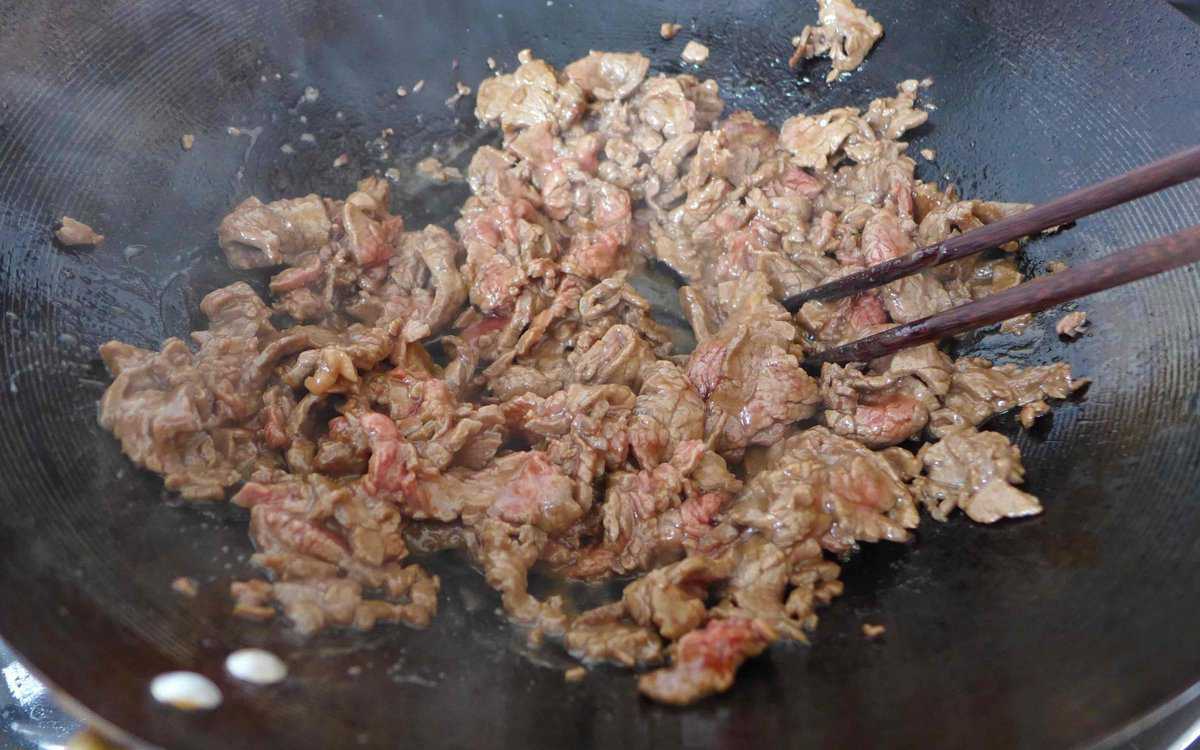
In this step, sear the marinated beef in a little oil until it’s half-cooked (the surface of the meat just loses its pinkness).
To achieve a succulent result, it’s key to cook the beef as fast as possible to retain its moisture. To achieve this, it’s best to use a carbon steel wok if available and keep the heat high.
Step 4: Stir-fry the dish
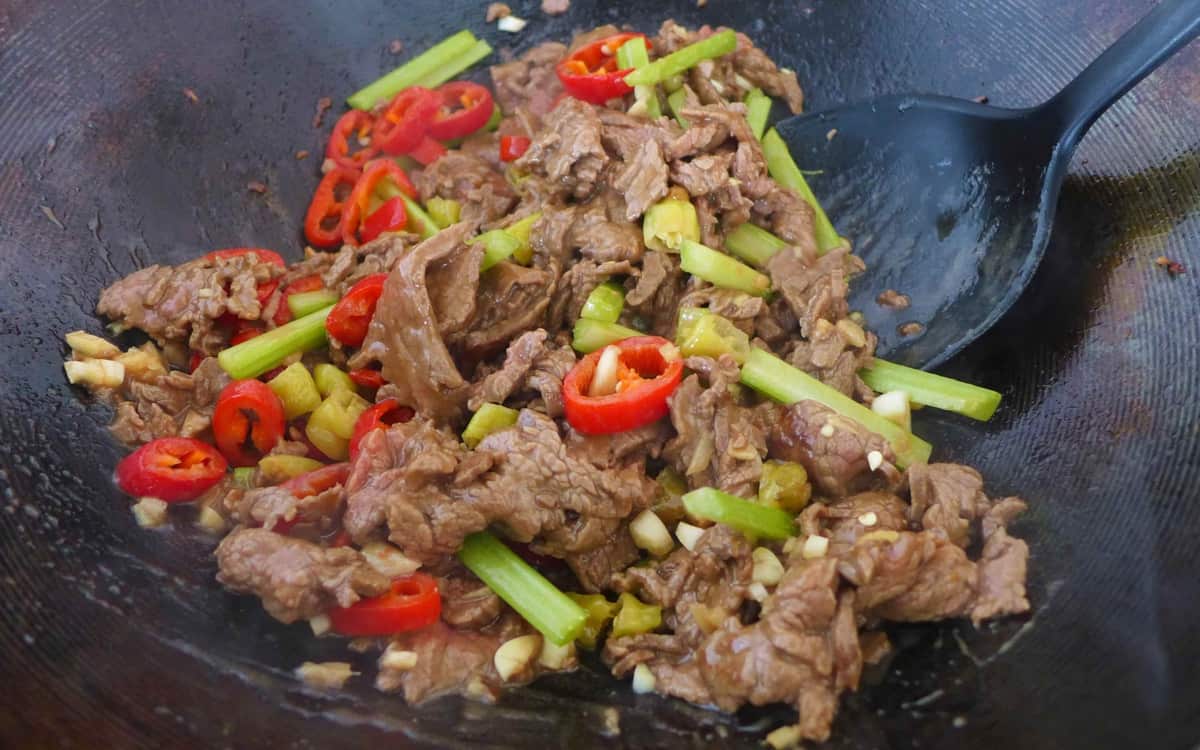
Add fresh chilli, pickled chilli, celery, garlic and ginger to the beef. Stir and toss constantly to distribute the heat evenly. Dish out after no more than 1 minute. You should be able to smell the aroma released from the vegetables (do not overcook).
Now, enjoy it warm with a bowl of steamed rice. I’ve also used it to stuff Bao Buns. Equally delicious!
Other quick stir-fries
Looking for more quick and easy recipes? Try these classic stir-fries!
📋 Recipe
Love this recipe? Please leave a 5-star 🌟🌟🌟🌟🌟 rating in the recipe card below & if you REALLY like it, consider leaving a comment as well!

Hunan Beef Stir-fry (小炒黄牛肉)
Ingredients
For the beef
- 350 g beef (skirt or flank steak) - about 12oz, see note 1
- 1 tablespoon oyster sauce
- 1 teaspoon light soy sauce
- 1 teaspoon dark soy sauce
- 1 teaspoon Shaoxing rice wine
- 1 teaspoon cornstarch
- 1 pinch white pepper
- 1 teaspoon neutral cooking oil
For stir-frying
- 2 tablespoon neutral cooking oil
- 30 g fresh chilli pepper, chopped - or to taste
- 20 g pickled chilli pepper, chopped - or to taste
- 60 g celery, julienned - can be replaced by coriander
- 1 tablespoon minced garlic
- 1 teaspoon minced ginger
Instructions
Marinate the beef
- Cut the beef into thin slices across the grain. To make cutting easier, you may put it in the freezer for 1-2 hours until it’s semi-frozen.
- In a bowl, mix oyster sauce, light soy sauce, dark soy sauce, Shaoxing rice wine, cornstarch and white pepper. Put in the beef. Gently rub until the meat fully absorbs the marinade.
- Add 1 teaspoon of oil and mix well. Leave to marinate for 10 minutes or so.
Stir-fry the dish
- Heat an empty wok over high heat until smoking hot (see note 2 if using non-stick cookware). Pour in 2 tablespoons of oil and swirl to coat the perimeter of the wok.
- Add the beef. Separate and flip the pieces with chopsticks to fry them evenly.
- As soon as most of the beef loses its pinkness, put in the rest of the ingredients (fresh chilli, pickled chilli, celery, garlic and ginger). Retain the high heat and toss constantly for about 1 minute.
- Dish out and serve immediately with steamed rice.
NOTES
NUTRITION
NUTRITION DISCLOSURE: Nutritional information on this website is provided as a courtesy to readers. It should be considered estimates. Please use your own brand nutritional values or your preferred nutrition calculator to double check against our estimates.



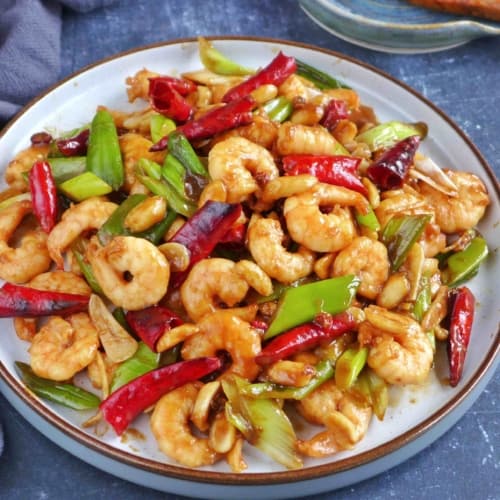
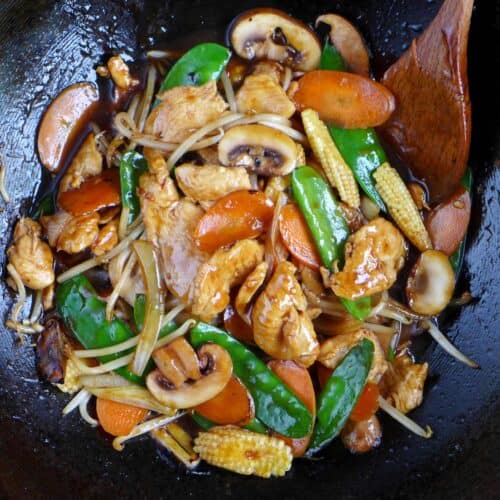
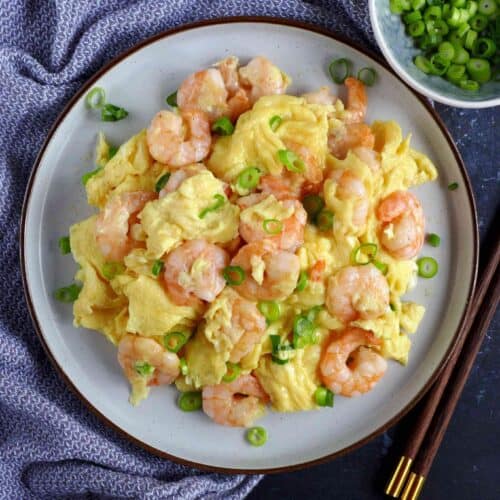





Hi Wei,
Cooked this dish and it came out spot on. Really satisfying to nail down a new dish just right the very first try. Wei, I’m interested to know if you could post up a recipe on plain old fish Siumai.
Happy to hear you liked this beef dish. I haven’t made Siumai with fish but I’ve shared a shrimp & pork siumai recipe. Will take a note and try it one day.
Dear Wei,
I worked with Houjie Town factories in Dongguan while I was based in Hong Kong for gone 20 years. Many of the owners were from Hunan. I was basically eating Hunan food for lunch twice a week for more than 10 years. I hope my question’s not a lame one. I just want to know what happens with the beef marinate. Is that tossed in as well?
Hi Paul! As I described in the post “gently rub the beef until no more liquid can be seen”. The marinade is fully absorbed by the beef, so when you add the beef to the wok, there shouldn’t be any liquid/sauce left in the bowl.
I love this dish so much but the first time I made it I didn’t have the peppers or the chilis so I used fresH onion and sambas olek. I love it like this so much I keep making it the same way 3 mor times and I’m hooked. I do love celery and chilis so I will try it as written someday soon. Thank you so much Wei!!! Love everything about your recipes and videos and guest appearances. Hope to someday go on one of your food tours!!♥️
That’s wonderful to hear Lydia! Yes, once you know the basics about this stir-fry, you can improvise with many different vegetables. Glad you liked it!